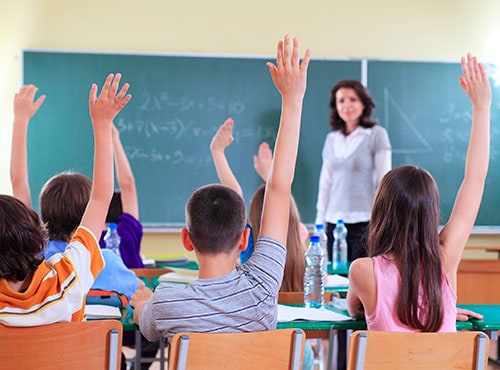
Misconception: If my lesson is interesting and engaging enough, students will be so enamored and awed, that they will not misbehave at all.
Anyone who’s spent considerable time in a classroom will probably chuckle at this. A friend of mine once said that she could be wearing a clown costume and juggling flaming batons and it wouldn’t be enough to motivate and engage students. Research agrees. The National Council on Teacher Quality (NCTQ)1 says that engaging academic lessons are not enough to create a well-managed classroom. Instead, teachers should rely on research-based strategies. A good place to start is with what NCTQ calls The Big Five.
1. Rules: Establish and teach rules
2. Routines: Establish and teach routines
3. Praise: Reinforce and praise positive behavior
4. Misbehavior: Issue consequences for misbehavior
5. Engagement: Teach interesting lessons with student participation
Teacher preparation programs overwhelmingly focus on the 5th point-Engagement but spend very little time preparing educators in the first four areas. Leaving teachers frustrated and students confused about behavioral expectations.
Let’s apply what we know about evidence-based academic teaching strategies as outlined by The Australian Society for Evidence-Based Teaching2 and apply that to behavioral teaching:
1. Determine clear lesson goals: Clearly defined lesson goals are more effective in driving student achievement than simply holding students to high expectations.3 Decide exactly what you want students to know and use this to guide lesson design and delivery.
Behavioral implication: Clearly define your behavioral expectations for specific tasks students need to complete. This may include listening during instruction or your expectations when working in a group. Clearly describe the specific behaviors, or desired outcome, to students in terms of what you want to see, what you want to hear or what you want to receive. Describe behavior as if you are holding up a mirror.
2. Show and tell: Expectations for a lesson or concept must be accompanied by modeling concepts and behaviors. Show students exactly how they can be successful.
Behavioral implications: Teach students behavioral expectations through modeling, breaking down tasks and showing students exactly how you expect something to be done. Modeling is important not only during the teaching of expectations but also in your own behavior and interactions with students and colleagues.
3. Check for understanding: During a lesson check for student understanding before moving on to the next steps or concepts. Asking specific questions or doing practice problems is a great way to ensure students understand the lesson.
Behavioral implications: When reviewing behavioral expectations, check for students’ understanding. This might include: asking students to paraphrase the expectations, having a student model the behavior or having students explain the expectation to each other.
4. Summarize new learning in a graphic representation: Use graphic representations in addition to linguistic explanations to teach content. This is similar to the concept of show and tell.
Behavioral implications: To increase students’ use of desired behavior, try using graphic representations to convey expectations. This might include (but are not limited to): T-charts of correct and incorrect behaviors, posters of what proper behavior looks like, for example a picture of what a listening body looks like, step by step instructions using icons to remind students how to perform certain routines or meet expectations.
5. Practice, especially over a spaced-out period of time: Student achievement is largely tied to student practice. When students correctly practice what has been taught during show and tell, it results in increased student understanding and use of skills. Practice is especially potent when used over time.
Behavioral implications: Giving students many opportunities over time to practice and demonstrate the desired behavior makes it more likely students will learn and exhibit the behavior when expected. Students can role-play, create posters or write stories to practice and demonstrate appropriate behavior. Practice also plays a key role when misbehavior occurs. Reteach any skills to help students meet behavioral expectations and have them practice during your corrective interaction.
6. Provide feedback: Providing feedback should include praise of what the student did well and providing any specific feedback on how they can improve.4
Behavioral implications: Providing behavioral feedback is almost identical to providing academic feedback. Even if a student did not meet the behavioral expectations, there is always something positive to praise. Follow this with a specific explanation of how students can meet expectations in the future.
7. Be flexible about how long it takes to learn: An important way to differentiate learning is to maintain the same learning goal while allowing students to practice the skill until they have mastered it. This is a central tenet of mastery learning.5
Behavioral implications: As teachers, we have a clear understanding of desired student behavior. While some students readily demonstrate appropriate learning behavior, others struggle. It’s important that we don’t lower our expectations for students but approach behavior as learning, just like academics. Some students need additional practice, time and feedback. Allowing for additional learning time provides students the opportunity to successfully meet expectations.
8. Get students working together (in a productive way): It’s important to provide ample opportunities for students to work together, ensuring each student has a task so they can contribute to the final outcome.
Behavioral implications: When students work cooperatively, they are provided the opportunity to apply social skills, like working with others, staying on task, having a conversation, asking for help and using appropriate voice tone. Teaching and reminding students of the expected skills just before a cooperative activity and providing individual feedback during the activity allows students to practice the appropriate behavior in a safe and learning-focused environment.
9. Teach problem-solving strategies, not just content: Teaching content without problem-solving techniques confines students to use academic skills only in familiar contexts. Teaching students problem-solving strategies to tackle unknown situations and problems that might arise equips them with the necessary tools to be independently successful.
Behavioral implications: While it’s important for students to be able to demonstrate compliance-based behaviors like following instructions, accepting criticism and accepting no, students must be able to problem-solve and navigate unknown social situations. Problem-solving skills may include how to regulate their emotions, how to advocate for themselves, how to disagree appropriately and how to use a social filter. These skills equip kids with the necessary tools to be better self-managers.
10. Nurture Metacognition: Metacognition is not just applying problem-solving strategies but thinking about choices before acting and the possible consequences of those choices. Encourage metacognition by having students verbalize how they might tackle a problem, why they chose this strategy and how it might help them accomplish the goal.
Behavioral implications: When teaching social-emotional skills to students, having them discuss, write, draw or act out possible choices and outcomes before they try their solution allows for metacognition, encourages executive functioning and increases the demonstration of positive behavior. Use problem-solving methods, SODAS and POP, to help students with executive function and metacognition in the context of social and behavioral decisions.
So what to do next? Play to your strengths. Think about which of these strategies you excel at in an academic context. Think about how you might use those same strategies to effectively teach students how to manage their own behavior and the likely outcomes of applying those strategies to behavior. Consider how students’ behavioral learning might affect time-on-task and academic outcomes.
Greenberg, J., Putnam, H., & Walsh, K. (2014). Training our Future Teachers: Classroom Management(pp. 1-54, Rep.). Washington, DC: National Council on Teacher Quality.
Killian, S. (2013, November 20). Top 10 Evidence Based Teaching Strategies. Retrieved August 7, 2017, from http://www.evidencebasedteaching.org.au/evidence-based-teaching-strategies/
Hattie, J. (2012). Visible Learning For Teachers. Routledge.
Marzano, R. J., Pickering, D. J., & Pollock, J. E. (n.d.). Classroom Instruction That Works. Alexandria, VA: ASCD.
Gusky, T. R., & Gates, S. L. (1986). Synthesis of Research on the Effects of Mastery Learning in Elementary and Secondary Education. Educational Leadership,43(8), 73-80.
